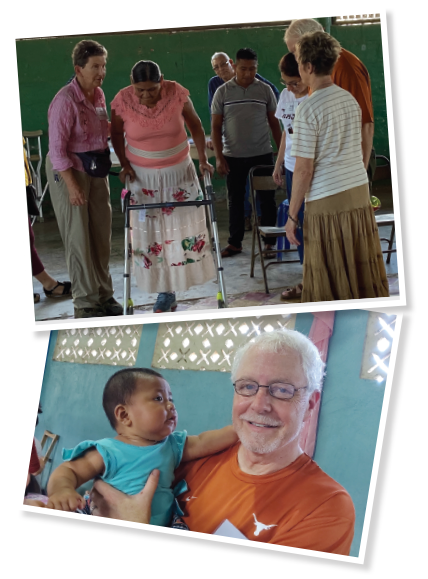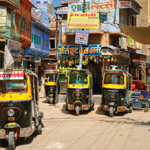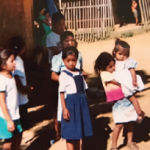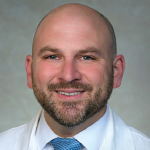Village Medicine

Top: An amputee with a broken wheelchair learns to use a walker.
Dr. Battafarano holds a baby.
Each day we traveled in an old, yellow school bus with broken windows to a different small village, passing through flooded areas, rainforests and plantations to establish mobile clinics under the metal roof of a church or in building shells with dirt floors. Our cell phones, without reception, were limited to taking photographs, but this also insulated us from any distractions back home. The verdant landscape and majestic mountains in the background did not hide the nearby images of poverty and shacks.
Small-statured adults standing in never-ending lines waited patiently to be seen, even after walking for hours to present their chief complaint. It was rare to see anyone smoking any form of tobacco. All of the patients respectfully arrived well groomed, despite their long travels. Most women wore colorful skirts and sandals, sometimes a flashy rosary hung from a woman’s neck as if it were a piece of jewelry. Their Mayan features were distinct, with dark eyes, some with sleepy eyelids, high cheekbones and straight, black hair. My own fair skin, blue eyes and gray-white hair was a contrast for the babies in my arms, who curiously tugged my hair and white goatee. The children appeared so innocent and adorable. Patients were usually accompanied by at least three well-behaved children, with the oldest clearly assisting mom with the clan. Children ran around, happily playing simple games as if they were in a city park.
The demeanor of each patient was generally very pleasant, respectful, yet stoic. Each adult patient carried a clinical paper to their exam station with their first name, age and, sometimes, a chief complaint. I celebrated every person’s introduction by calling their traditional Spanish names; each one responded with a wide smile, often correcting my pronunciation.
Not until the initial clinic did I realize we needed two translators for each patient. My English questions were translated into Spanish for the bilingual Spanish/Mayan translator who ultimately interviewed the patient in Q’eqchi (pronounced kekchi) and translated the responses back, in reverse, for each patient encounter.
After thorough, back-and-forth translated interviews regarding complaints or concerns, I was able to focus on my examination. Like in Texas, children and adults had common infections, but scabies, parasites and poor dentition were common, too. Overuse syndromes and OA were frequently seen, consistent with their demanding farming and physical lifestyles. Occasional soft tissue injections were necessary.
To my surprise, not one patient over five days of clinic had inflammatory joints, rheumatoid arthritis (RA) or rheumatic fever.
A 12-year-old boy presented with symmetrical, nontender bony hypertrophy of bilateral distal radii and proximal tibias, but no synovitis, and full range of motion in his fingers, wrists and knees. We referred him to a medical center for an optimal assessment with imaging studies.
Chronic pain symptoms were distinctly absent. I only saw two women during the entire week with obvious fibromyalgia and associated depression. One patient had a physically abusive marriage, and the other mother was grieving the loss of her 4-month-old child. Unfortunately, consults to psychology or social work were not an option in this community.
Many slender patients presented with new-onset, type 2 diabetes mellitus (DM), with fingerstick glucose levels over 350 mg/dL, but they lacked the apple-shaped body habitus. Dangerously high hypertension was responsive to clonidine therapy, thankfully. Thyroid goiters were readily observed in clinically euthyroid patients. Breast masses and ascites had to be facilitated to a medical center in Guatemala City by our local colleagues.
Before leaving clinic with their vitamins, every patient took a swig of albendazole for possible parasites.
In the end, I suspected there must have been some cardiac, stroke and/or cancer patients in their homes who were too frail to make it to our clinic.
We rendered medical care nonstop all day, yet each day felt like a refreshing treat without the headaches caused by using electronic medical records or delays waiting for drug approvals.
Adults were appreciative of their medical care in each interaction. Selected patients were fitted by a physical therapist with donated shoes to prevent infections or to improve a disabling gait. A couple of times, a team member donated perfectly sized running shoes right off their own feet for individual patients and swapped another pair to wear from the donated shoe bin, even if they were too large. Young children could not have been happier leaving the clinic with gifts of simple toys, and the girls, especially were excited about pretty, hand-me-down clothes.



